Synthesis and Characterization of Chitosan-Based Nanodelivery Systems to Enhance the Anticancer Effect of Sorafenib Drug in Hepatocellular Carcinoma and Colorectal Adenocarcinoma Cells
Abstract
1. Introduction
2. Materials and Methods
2.1. Materials
2.2. Synthesis of Sorafenib-Loaded Chitosan Nanoparticles
2.3. Preparation of Folic Acid-Conjugated Chitosan Sorafenib Nanoparticles
2.4. Physico-Chemical Characterization
2.5. Encapsulation Efficiency (EE%) and Loading Content (LC%)
2.6. In Vitro Drug Release Study
2.7. In Vitro Cell Viability Assay
3. Results and Discussion
3.1. Optimization of Particle Size, Poly Dispersity Index, Encapsulation and Loading Efficiency, and Zeta Potentials
3.2. Particle Size Distribution
3.3. X-ray Diffraction
3.4. Surface Properties Using Field Emission Scanning Electron Micrographs and Qualitative Elemental Analysis Using Energy Dispersive X-ray
3.5. High-Resolution Transmission Electron Micrograph
3.6. Fourier Transform Infrared Spectroscopy
3.7. Thermogravimetric and Differential Thermogravimetric Analyses
3.8. In-Vitro Drug Release
3.9. Release Kinetics Study
3.10. In Vitro Cytotoxicity Studies
3.10.1. In Vitro Cytotoxicity Study of Normal Human Dermal Fibroblast Adult Cells
3.10.2. Anticancer Activity against Liver Cancer, HepG2 Cells
3.10.3. Anticancer Activity against Colorectal Cancer, HT29 Cells
4. Conclusions
5. Future Aspects
Author Contributions
Funding
Acknowledgments
Conflicts of Interest
Abbreviations
| NPs | Nanoparticles |
| CS-NPs | Chitosan nanoparticles |
| CS | Chitosan |
| DLS | Dynamic light scattering |
| HCL | Hydrochloride |
| TEM | Transmission electron microscopy |
| TPP | Sodium Tripolyphosphate |
| UV-Vis | Ultraviolet-visible spectroscopy |
| DMSO | dimethyl sulfoxide |
| MTT | methyl thiazol tetrazolium bromide |
| NaOH | sodium hydroxide |
| nm | nanometer |
| PBS | phosphate-buffered saline |
| TPP | (sodium) tripolyphosphate |
| EPR | Enhanced Permeability and Retention |
| EDX | Energy Dispersive X-ray |
| FESEM | Field Emission Scanning Electron Microscopy |
| FTIR | Fourier Transform Infrared |
| XRD | X-ray spectroscopy |
| EE | Encapsulation Efficiency |
| LC | Loading Content |
| M | molar |
| mg | milligram |
| min | minute(s) |
| ml | milliliter |
| Hep G2 | —Hepatocellular Carcinoma cell |
| HT29 | Colorectal Adenocarcinoma Cell Lines |
References
- Senapati, S.; Mahanta, A.K.; Kumar, S.; Maiti, P. Controlled drug delivery vehicles for cancer treatment and their performance. Sign. Transduct. Target. Ther. 2018, 3, 1–19. [Google Scholar] [CrossRef] [PubMed]
- Sia, D.; Villanueva, A.; Friedman, S.L.; Llovet, J.M. Liver cancer cell of origin, molecular class, and effects on patient prognosis. Gastroenterology 2017, 152, 745–761. [Google Scholar] [CrossRef] [PubMed]
- Torre, L.A.; Bray, F.; Siegel, R.L.; Ferlay, J.; Lortet-Tieulent, J.; Jemal, A. Global cancer statistics, 2012. CA Cancer J. Clin. 2015, 65, 87–108. [Google Scholar] [CrossRef]
- Favoriti, P.; Carbone, G.; Greco, M.; Pirozzi, F.; Pirozzi, R.E.M.; Corcione, F. Worldwide burden of colorectal cancer: A review. Updates Surg. 2016, 68, 7–11. [Google Scholar] [CrossRef] [PubMed]
- Bray, F.; Ferlay, J.; Soerjomataram, I.; Siegel, R.L.; Torre, L.A.; Jemal, A. Global cancer statistics 2018: GLOBOCAN estimates of incidence and mortality worldwide for 36 cancers in 185 countries. CA: Cancer J. Clin. 2018, 68, 394–424. [Google Scholar] [CrossRef]
- Li, Y.J.; Dong, M.; Kong, F.M.; Zhou, J.P. Folate-decorated anticancer drug and magnetic nanoparticles encapsulated polymeric carrier for liver cancer therapeutics. Int. J. Pharm. 2015, 489, 83–90. [Google Scholar] [CrossRef] [PubMed]
- Park, K. Facing the truth about nanotechnology in drug delivery. ACS Nano 2013, 7, 7442–7447. [Google Scholar] [CrossRef] [PubMed]
- Ho, B.N.; Pfeffer, C.M.; Singh, A.T. Update on nanotechnology-based drug delivery systems in cancer treatment. Anticancer Res. 2017, 37, 5975–5981. [Google Scholar] [PubMed]
- Bugnicourt, L.; Ladavière, C. Interests of chitosan nanoparticles ionically cross-linked with tripolyphosphate for biomedical applications. Progress Polymer Sci. 2016, 60, 1–17. [Google Scholar] [CrossRef]
- Lee, M.; Nah, J.W.; Kwon, Y.; Koh, J.J.; Ko, K.S.; Kim, S.W. Water-soluble and low molecular weight chitosan-based plasmid DNA delivery. Pharm. Res. 2001, 18, 427–431. [Google Scholar] [CrossRef]
- Chae, S.Y.; Jang, M.K.; Nah, J.W. Influence of molecular weight on oral absorption of water soluble chitosans. J. Control. Release 2005, 102, 383–394. [Google Scholar] [CrossRef]
- Kudo, M.; Trevisani, F.; Abou-Alfa, G.K.; Rimassa, L. Hepatocellular carcinoma: Therapeutic guidelines and medical treatment. Liver Cancer 2017, 6, 16–26. [Google Scholar] [CrossRef]
- DiFrancesco, C. FDA Approves Nexavar for Patients with Inoperable Liver Cancer. 2007. Available online: http://www.fda.gov/NewsEvents/Newsroom/PressAnnouncements/2007/ucm109030.htm (accessed on 14 April 2016).
- Benson, A.B., 3rd; Abrams, T.A.; Ben-Josef, E.; Bloomston, P.M.; Botha, J.F.; Clary, B.M.; Covey, A.; Curley, S.A.; D’Angelica, M.I.; Davila, R.; et al. NCCN clinical practice guidelines in oncology: Hepatobiliary cancers. J. Natl. Compr. Cancer Netw. 2009, 7, 350–391. [Google Scholar] [CrossRef]
- Chang, Y.S.; Adnane, J.; Trail, P.A.; Levy, J.; Henderson, A.; Xue, D.; Wilkie, D. Sorafenib (BAY 43-9006) inhibits tumor growth and vascularization and induces tumor apoptosis and hypoxia in RCC xenograft models. Cancer Chemother. Pharmacol. 2007, 59, 561–574. [Google Scholar] [CrossRef]
- Cervello, M.; Bachvarov, D.; Lampiasi, N.; Cusimano, A.; Azzolina, A.; McCubrey, J.A.; Montalto, G. Molecular mechanisms of sorafenib action in liver cancer cells. Cell Cycle 2012, 11, 2843–2855. [Google Scholar] [CrossRef] [PubMed]
- Coriat, R.; Nicco, C.; Chereau, C.; Mir, O.; Alexandre, J.; Ropert, S.; Batteux, F. Sorafenib-induced hepatocellular carcinoma cell death depends on reactive oxygen species production in vitro and in vivo. Mol. Cancer Ther. 2012, 11, 2284–2293. [Google Scholar] [CrossRef]
- Chu, D.; Lacouture, M.E.; Fillos, T.; Wu, S. Risk of hand-foot skin reaction with sorafenib: A systematic review and meta-analysis. Acta Oncol. 2008, 47, 176–186. [Google Scholar] [CrossRef] [PubMed]
- Rink, J.S.; Plebanek, M.P.; Tripathy, S.; Thaxton, C.S. Update on current and potential nanoparticle cancer therapies. Curr. Opin. Oncol. 2013, 25, 646. [Google Scholar] [CrossRef]
- Xiao, Y.; Liu, Y.; Yang, S.; Zhang, B.; Wang, T.; Jiang, D.; Zhang, J.; Yu, D.; Zhang, N. Sorafenib and Gadolinium co-loaded liposomes for drug delivery and MRI-guided HCC treatment. Colloids Surf. B Biointerfaces 2016, 141, 83–92. [Google Scholar] [CrossRef] [PubMed]
- Kim, D.H.; Kim, M.D.; Choi, C.W.; Chung, C.W.; Ha, S.H.; Kim, C.H.; Kang, D.H. Antitumor activity of sorafenib-incorporated nanoparticles of dextran/poly (dl-lactide-co-glycolide) block copolymer. Nanoscale Res. Lett. 2012, 7, 91. [Google Scholar] [CrossRef]
- Pawlik, T.M.; Reyes, D.K.; Cosgrove, D.; Kamel, I.R.; Bhagat, N.; Geschwind, J.-F.H. Phase II trial of sorafenib combined with concurrent transarterial chemoembolization with drug-eluting beads for hepatocellular carcinoma. J. Clin. Oncol. 2011, 29, 3960–3967. [Google Scholar] [CrossRef]
- Yosef, H.K.; Frick, T.; Hammoud, M.K.; Maghnouj, A.; Hahn, S.; Gerwert, K.; El-Mashtoly, S.F. Exploring the efficacy and cellular uptake of sorafenib in colon cancer cells by Raman micro-spectroscopy. Analyst 2018, 143, 6069–6078. [Google Scholar] [CrossRef] [PubMed]
- Chang, Y.J.; Hsu, W.H.; Chang, C.H.; Lan, K.L.; Ting, G.; Lee, T.W. Combined therapeutic efficacy of 188Re‑liposomes and sorafenib in an experimental colorectal cancer liver metastasis model by intrasplenic injection of C26‑luc murine colon cancer cells. Mol. Clin. Oncol. 2014, 2, 380–384. [Google Scholar] [CrossRef]
- Li, N.; Chen, Y.; Sun, H.; Huang, T.; Chen, T.; Jiang, Y.; Wu, M. Decreasing acute toxicity and suppressing colorectal carcinoma using Sorafenib-loaded nanoparticles. Pharm. Develop. Technol. 2020, 25, 556–565. [Google Scholar] [CrossRef]
- Yap, T.A.; Carden, C.P.; Kaye, S.B. Beyond chemotherapy: Targeted therapies in ovarian cancer. Nat. Rev. Cancer 2009, 9, 167. [Google Scholar] [CrossRef]
- Choi, H.; Choi, S.R.; Zhou, R.; Kung, H.F.; Chen, I.W. Iron oxide nanoparticles as magnetic resonance contrast agent for tumor imaging via folate receptor-targeted delivery1. Acad. Radiol. 2004, 11, 996–1004. [Google Scholar] [CrossRef] [PubMed]
- Lu, Y.; Low, P.S. Immunotherapy of folate receptor-expressing tumors: Review of recent advances and future prospects. J. Controll. Release 2003, 91, 17–29. [Google Scholar] [CrossRef]
- Fang, C.; Veiseh, O.; Kievit, F.; Bhattarai, N.; Wang, F.; Stephen, Z.; Li, C.; Lee, D.; Ellenbogen, R.G.; Zhang, M. Functionalization Q10 of iron oxide magnetic 499 nanoparticles with targeting ligands: Their physicochemical properties and in 500 vivo behaviour. Nanomedicine 2010, 5, 1357–1369. [Google Scholar] [CrossRef]
- Sudimack, J.; Lee, R.J. Targeted drug delivery via the folate receptor. Adv. Drug Deliv. Rev. 2000, 41, 147–162. [Google Scholar] [CrossRef]
- Lu, Y.; Low, P.S. Folate-mediated delivery of macromolecular anticancer therapeutic agents. Adv. Drug Deliv. Rev. 2002, 54, 675–693. [Google Scholar] [CrossRef]
- Masarudin, M.J. Chitosan Nanoparticles as a Delivery Vehicle for [14C]-Doxorubicin and the formaldehyde Releasing Prodrug AN-250. Ph.D. Thesis, La Trobe University, Melbourne, Australia, 2012. [Google Scholar]
- Chavanpatil, M.D.; Khdair, A.; Panyam, J. Surfactant-polymer nanoparticles: A novel platform for sustained and enhanced cellular delivery of water-soluble molecules. Pharm. Res. 2007, 24, 803. [Google Scholar] [CrossRef]
- An, F.F.; Cao, W.; Liang, X.J. Nanostructural systems developed with positive charge generation to drug delivery. Adv. Healthcare Mater. 2014, 3, 1162–1181. [Google Scholar] [CrossRef] [PubMed]
- Masarudin, M.J.; Cutts, S.M.; Evison, B.J.; Phillips, D.R.; Pigram, P.J. Factors determining the stability, size distribution, and cellular accumulation of small, monodisperse chitosan nanoparticles as candidate vectors for anticancer drug delivery: Application to the passive encapsulation of [14C]-doxorubicin. Nanotechnol. Sci. Appl. 2015, 8, 67–80. [Google Scholar] [CrossRef] [PubMed]
- Clarke, S. Development of Hierarchical Magnetic Nanocomposite Materials for Biomedical Applications. Ph.D. Thesis, Dublin City University, Dublin, UK, 2013. [Google Scholar]
- Putri, D.C.; Dwiastuti, R.; Marchaban, M.; Nugroho, A.K. Optimization of mixing temperature and sonication duration in liposome preparation. J. Pharm. Sci. Commun. 2017, 14, 79–85. [Google Scholar] [CrossRef]
- Kalyane, D.; Raval, N.; Maheshwari, R.; Tambe, V.; Kalia, K.; Tekade, R.K. Employment of enhanced permeability and retention effect (EPR): Nanoparticle-based precision tools for targeting of therapeutic and diagnostic agent in cancer. Mater. Sci. Eng. C 2019, 98, 1252–1276. [Google Scholar] [CrossRef]
- Bertrand, N.; Wu, J.; Xu, X.; Kamaly, N.; & Farokhzad, O.C. Cancer nanotechnology: The impact of passive and active targeting in the era of modern cancer biology. Adv. Drug Deliv. Rev. 2014, 66, 2–25. [Google Scholar] [CrossRef]
- Cabral, H.; Matsumoto, Y.; Mizuno, K.; Chen, Q.; Murakami, M.; Kimura, M.; Nishiyama, N. Accumulation of sub-100 nm polymeric micelles in poorly permeable tumours depends on size. Nat. Nanotechnol. 2011, 6, 815–823. [Google Scholar] [CrossRef]
- Lustriane, C.; Dwivany, F.M.; Suendo, V.; Reza, M. Effect of chitosan and chitosan-nanoparticles on post harvest quality of banana fruits. J. Plant Biotechnol. 2018, 45, 36–44. [Google Scholar] [CrossRef]
- Elsayed, M.M.; Mostafa, M.E.; Alaaeldin, E.; Sarhan, H.A.; Shaykoon, M.S.; Allam, S.; Elsadek, B.E. Design and characterisation of novel Sorafenib-loaded carbon nanotubes with distinct tumour-suppressive activity in hepatocellular carcinoma. Int. J. Nanomed. 2019, 14, 8445. [Google Scholar] [CrossRef] [PubMed]
- İnce, İ.; Yıldırım, Y.; Güler, G.; Medine, E.İ.; Ballıca, G.; Kuşdemir, B.C.; Göker, E. Synthesis and characterization of folic acid-chitosan nanoparticles loaded with thymoquinone to target ovarian cancer cells. J. Radioanal. Nuclear Chem. 2020, 324, 1–15. [Google Scholar] [CrossRef]
- Wójcik-Pastuszka, D.; Krzak, J.; Macikowski, B.; Berkowski, R.; Osiński, B.; Musiał, W. Evaluation of the release kinetics of a pharmacologically active substance from model intra-articular implants replacing the cruciate ligaments of the knee. Materials 2019, 12, 1202. [Google Scholar] [CrossRef] [PubMed]

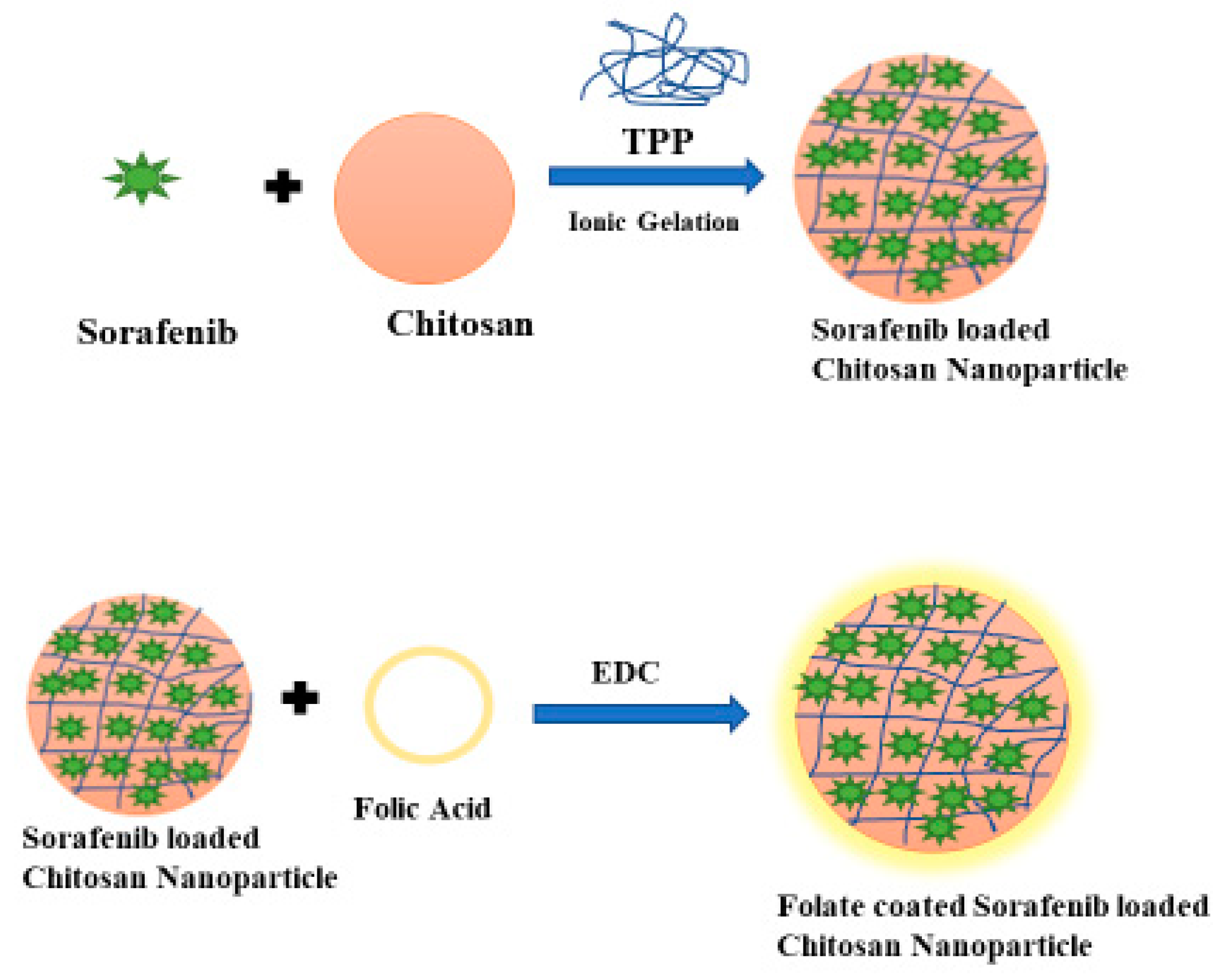
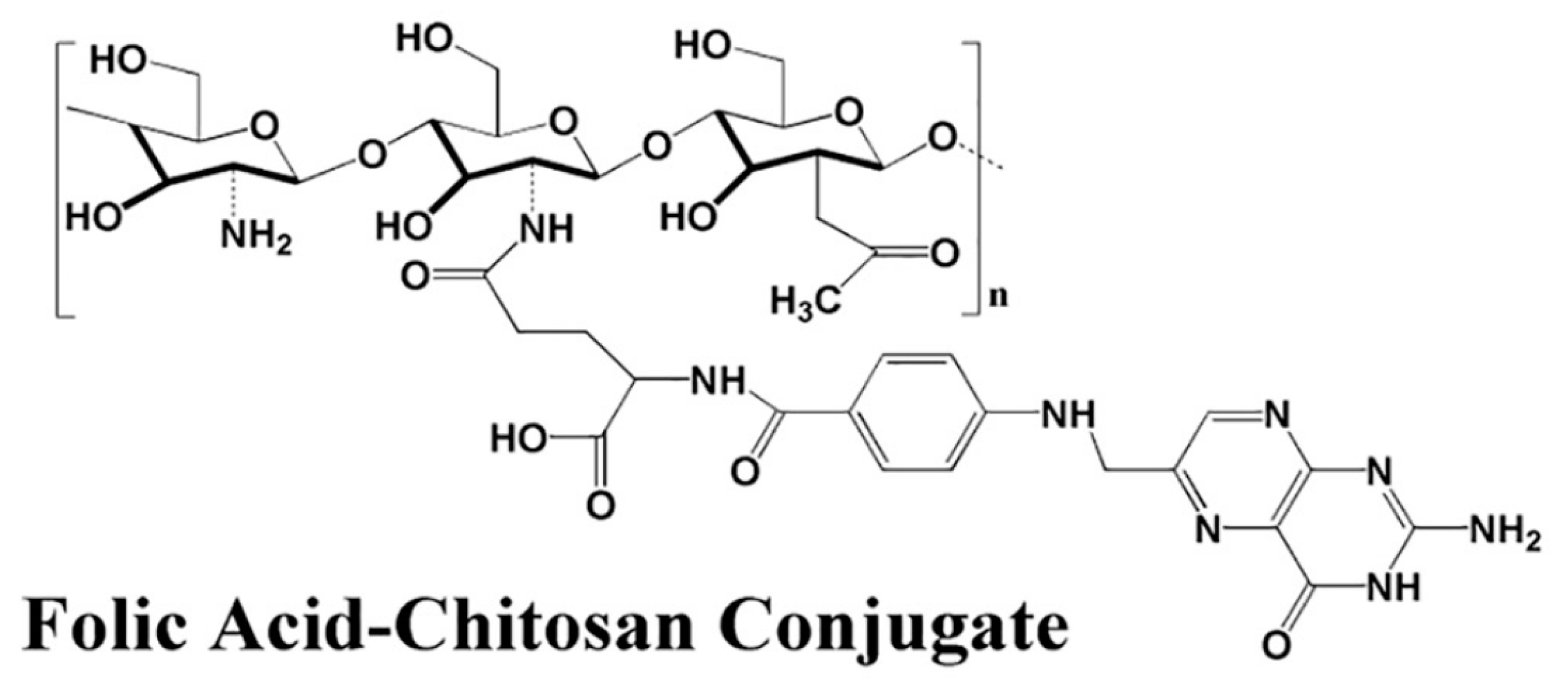
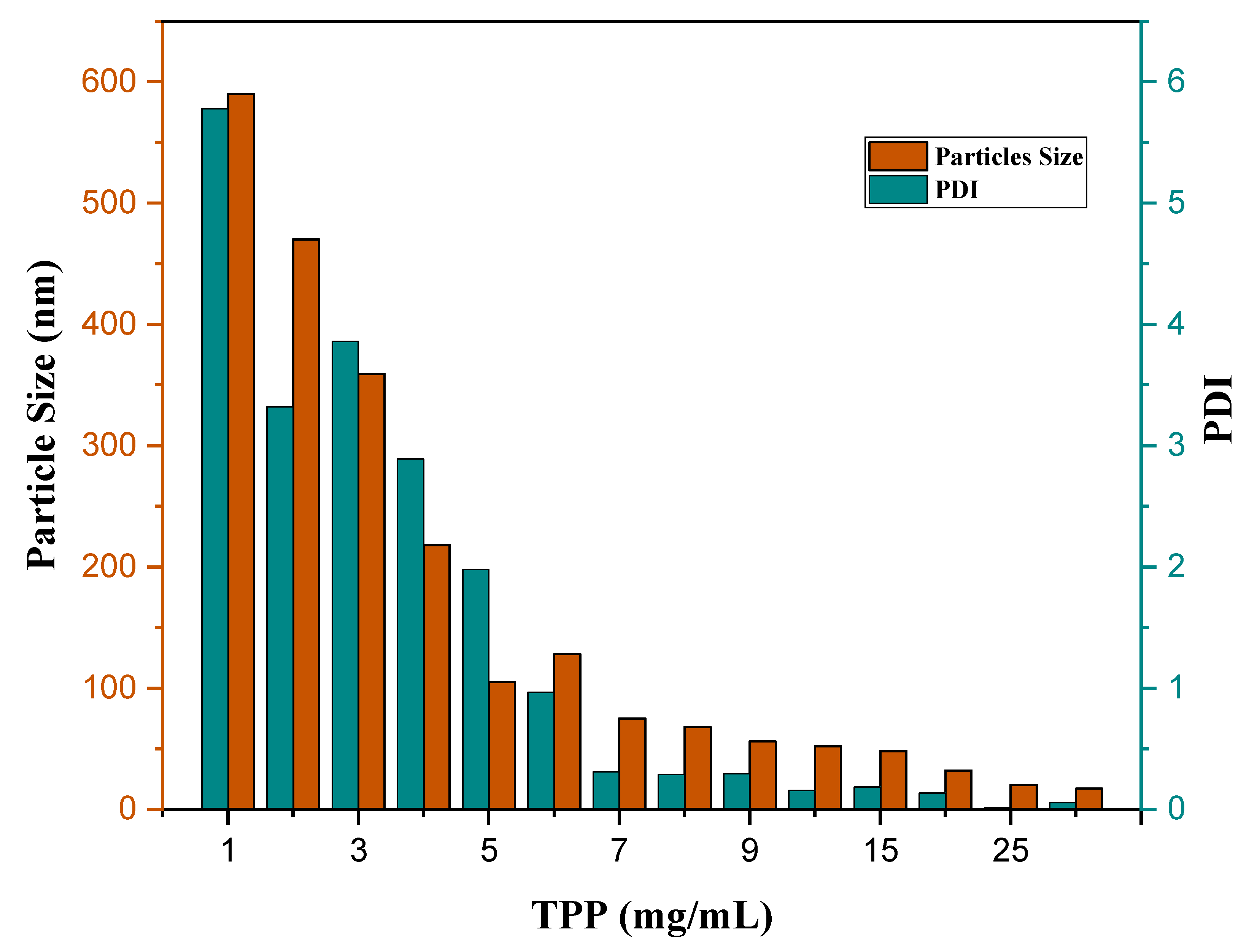
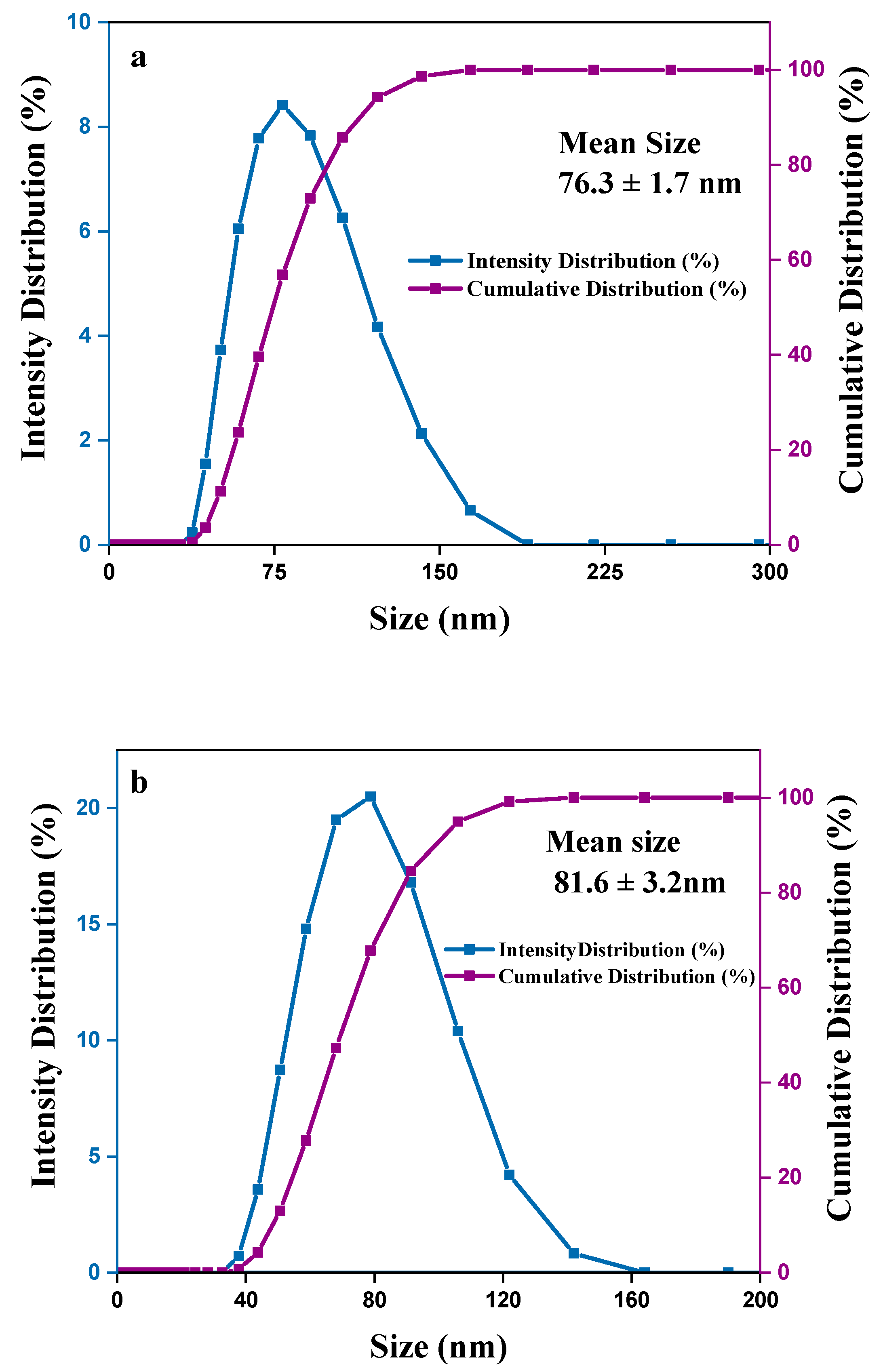
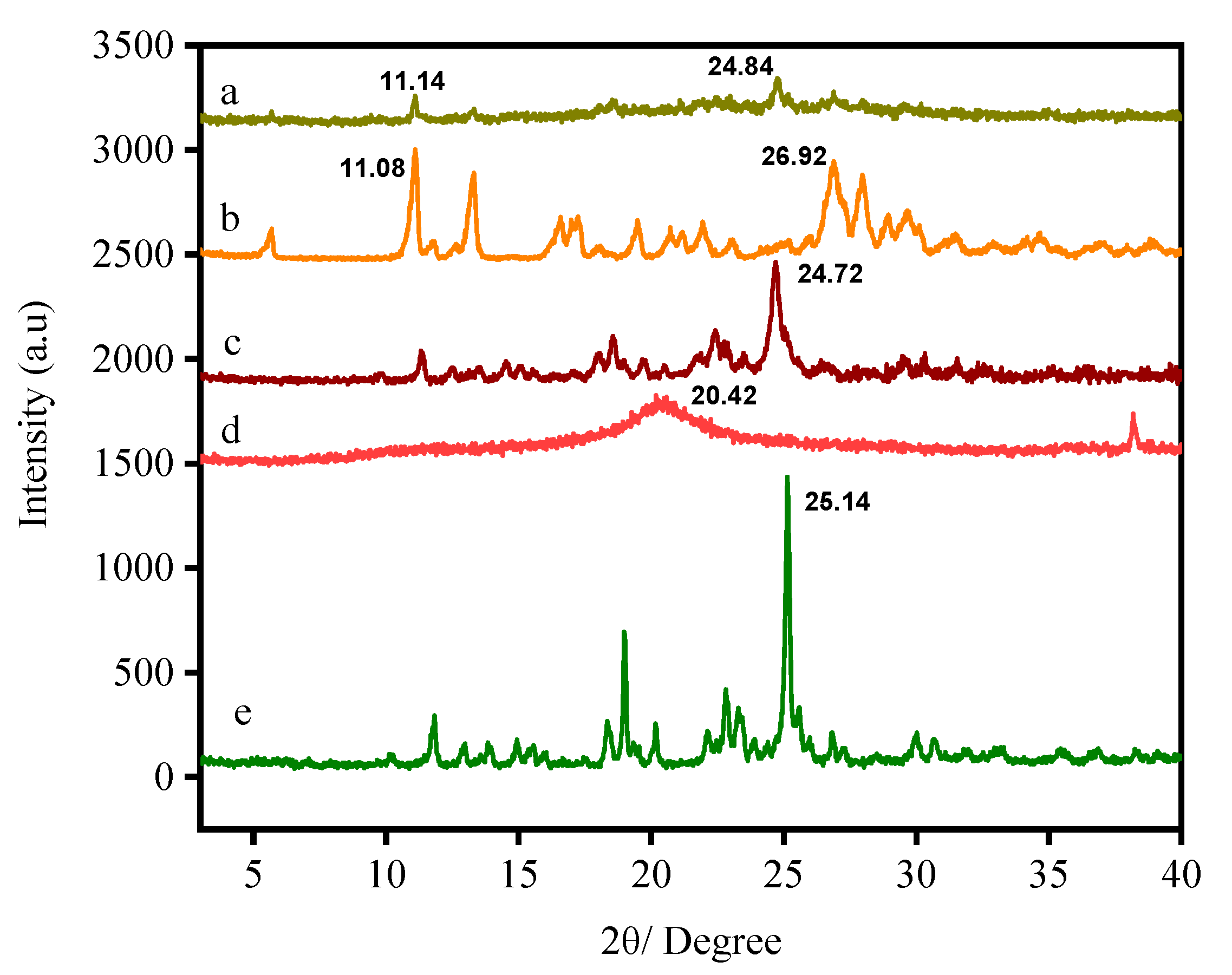
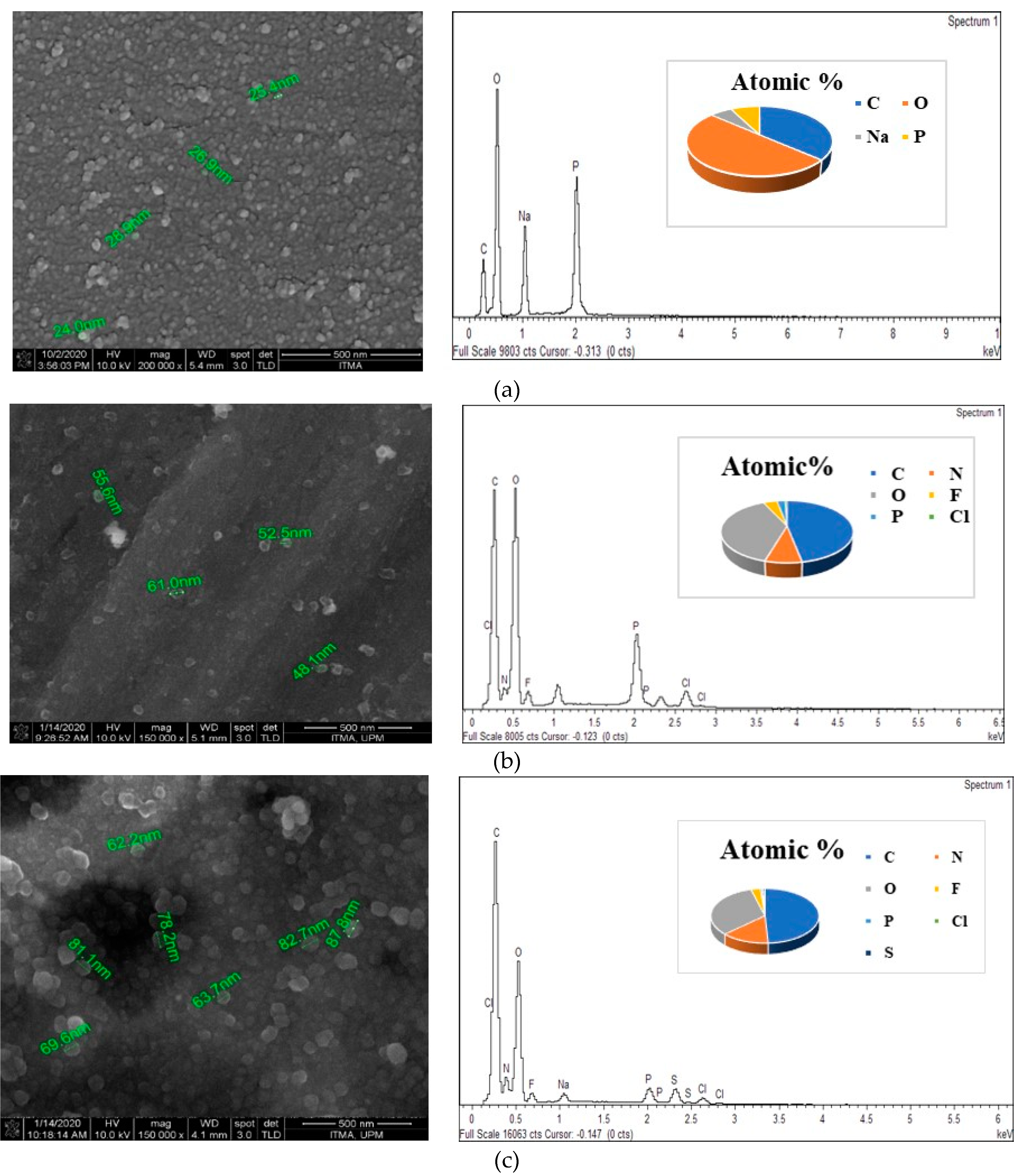
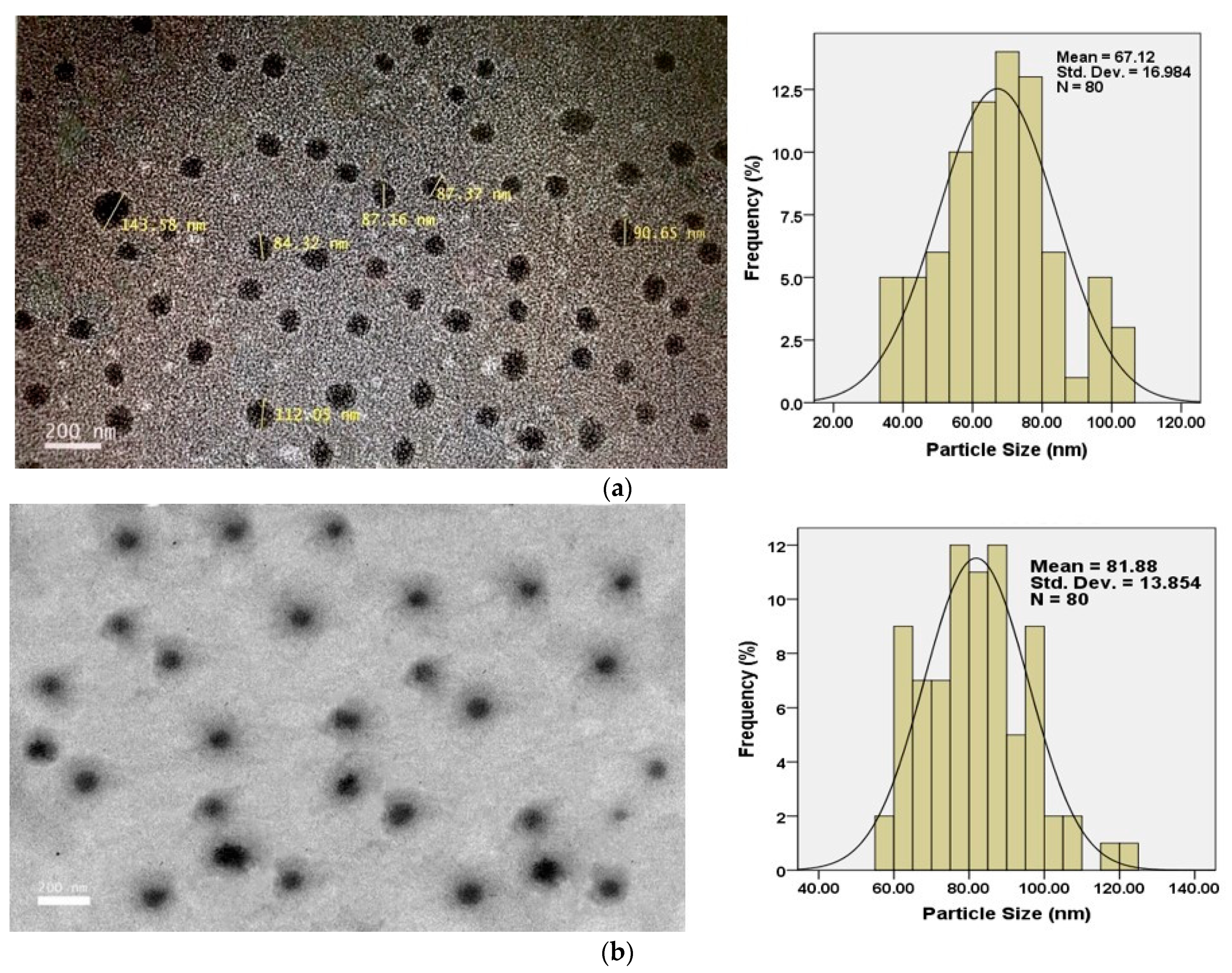
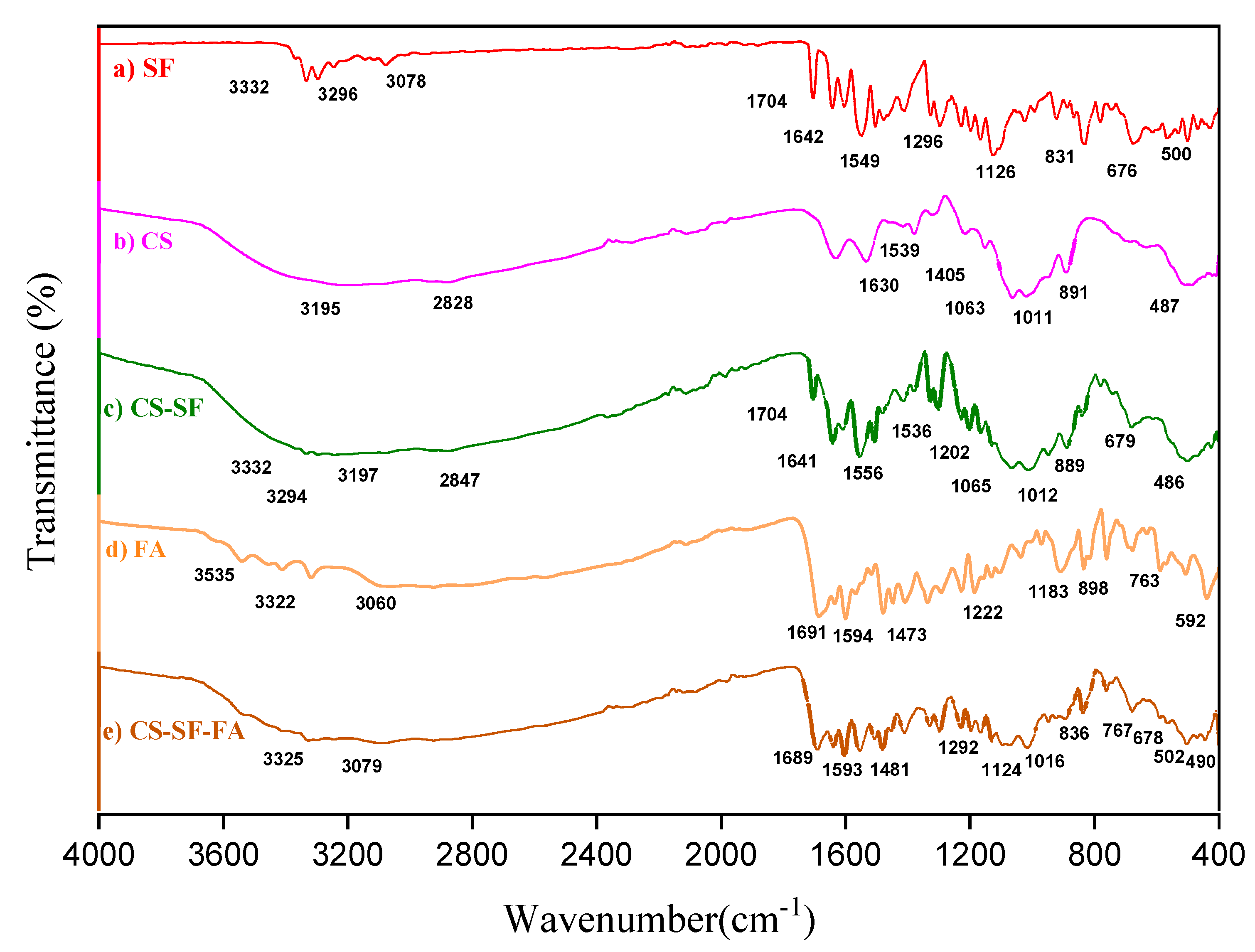
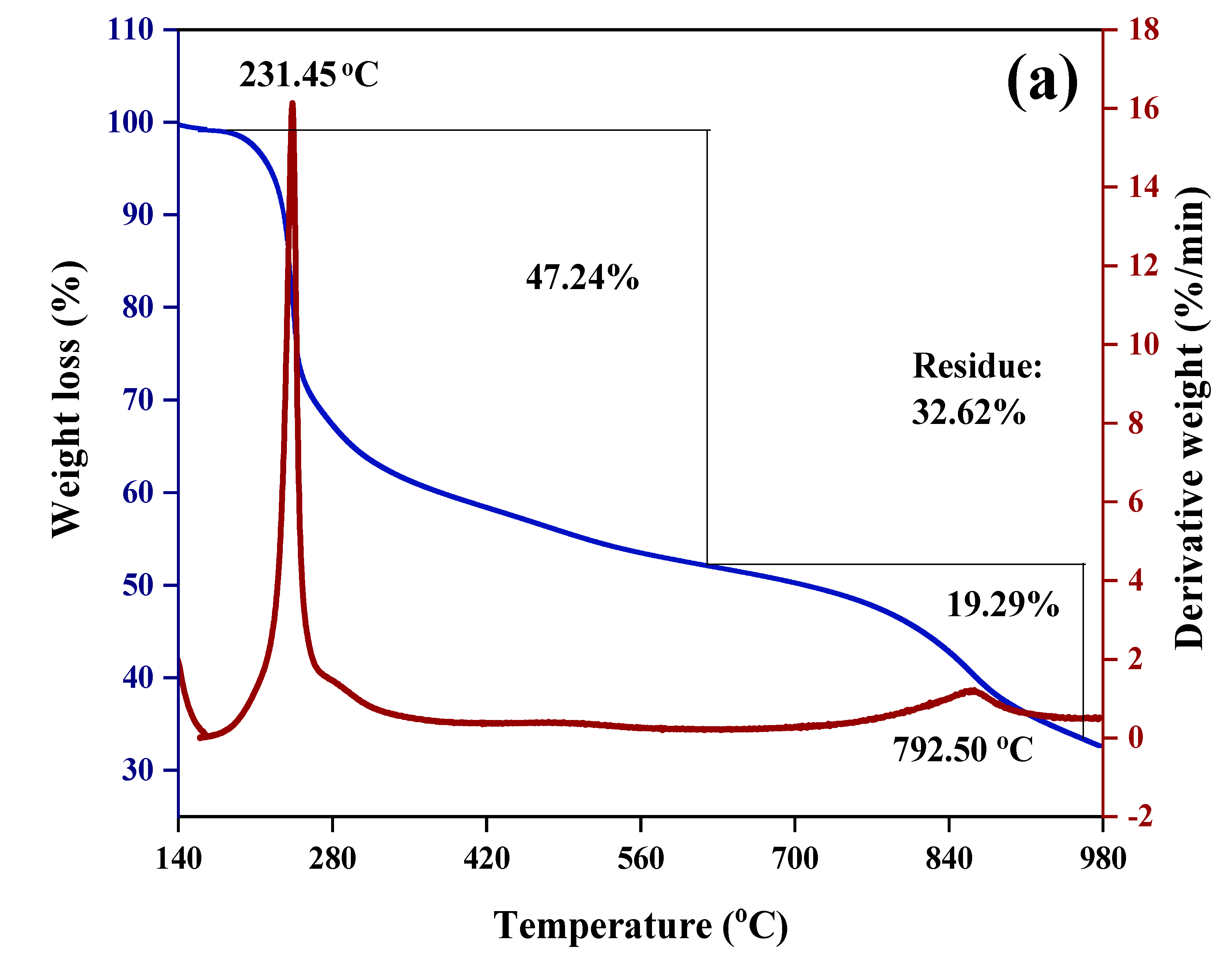
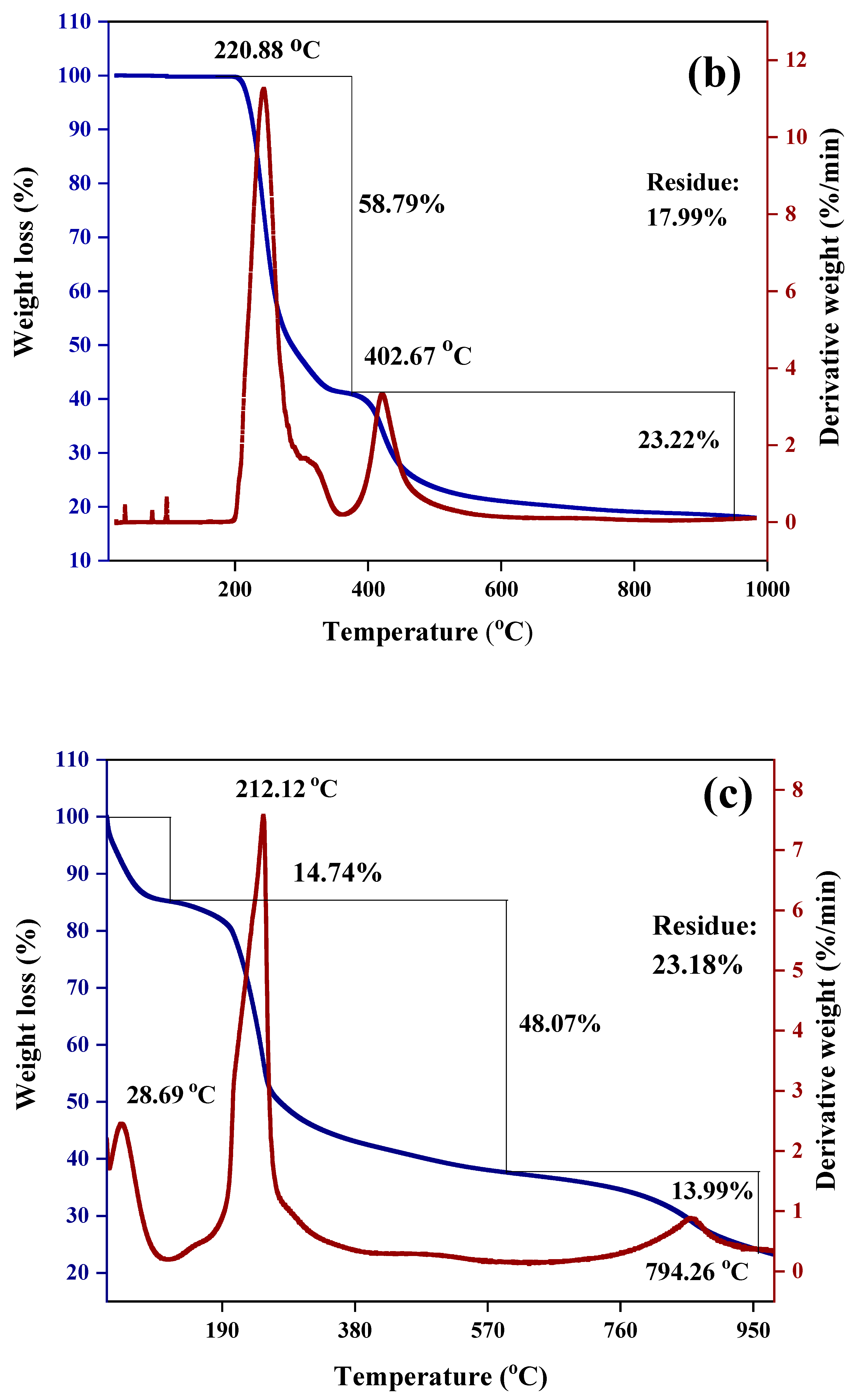
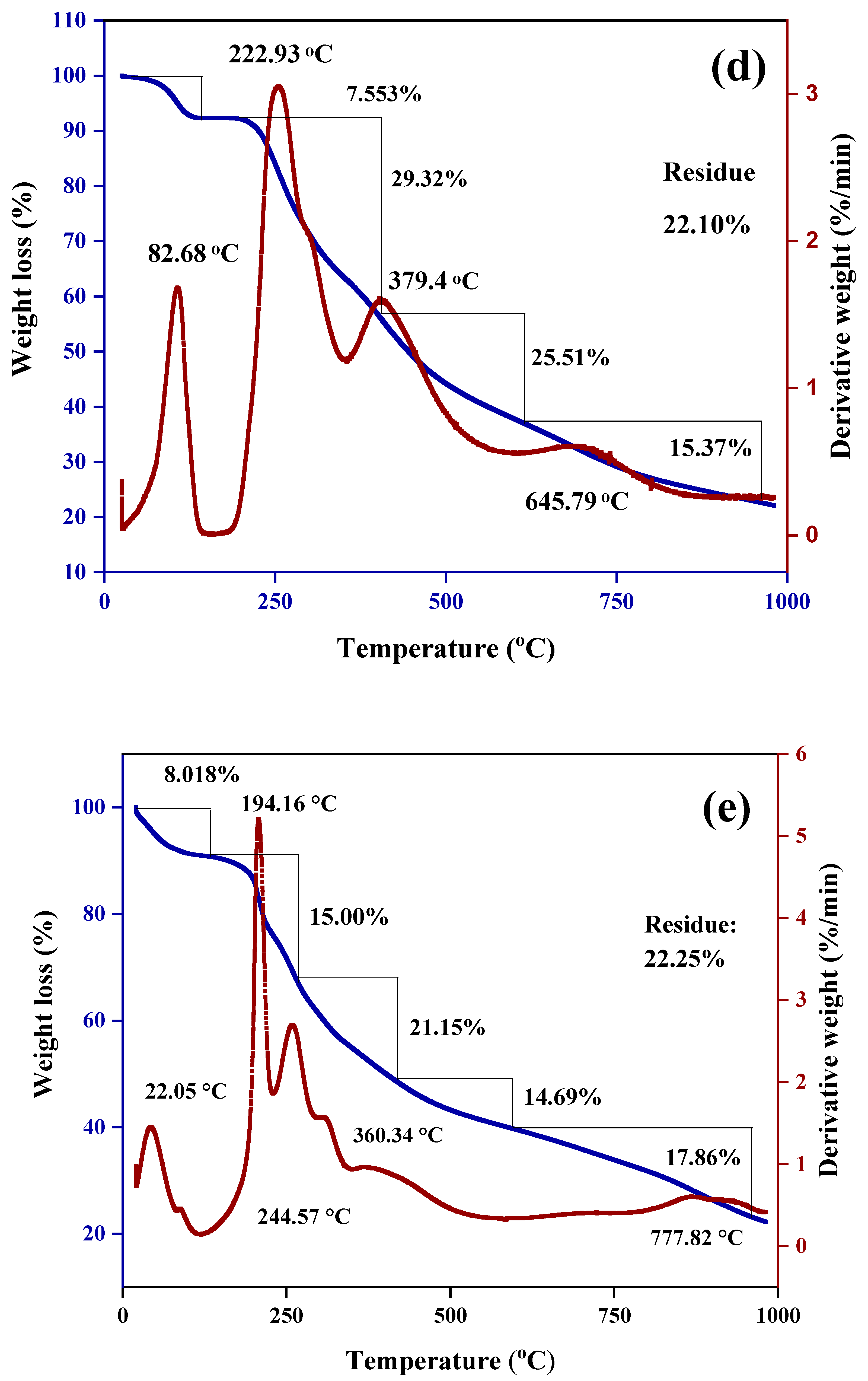
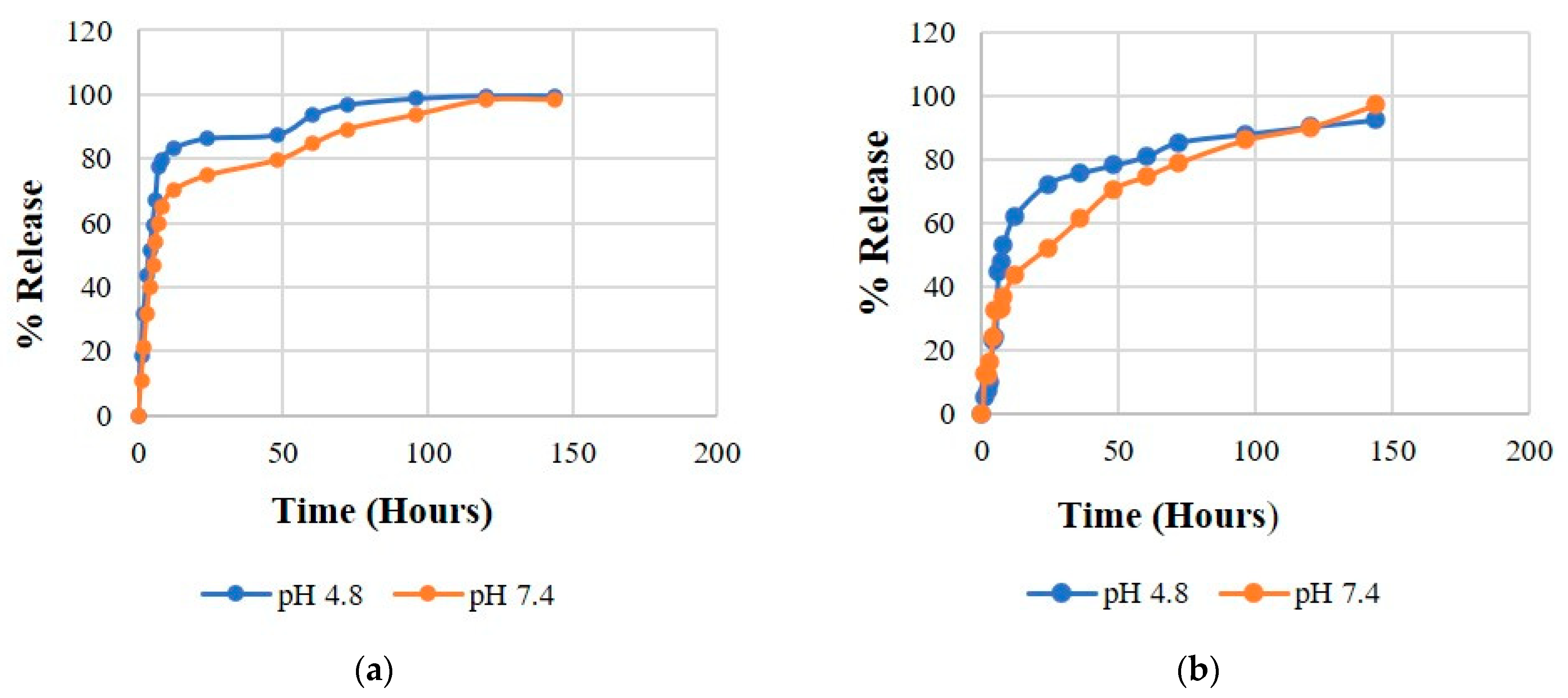
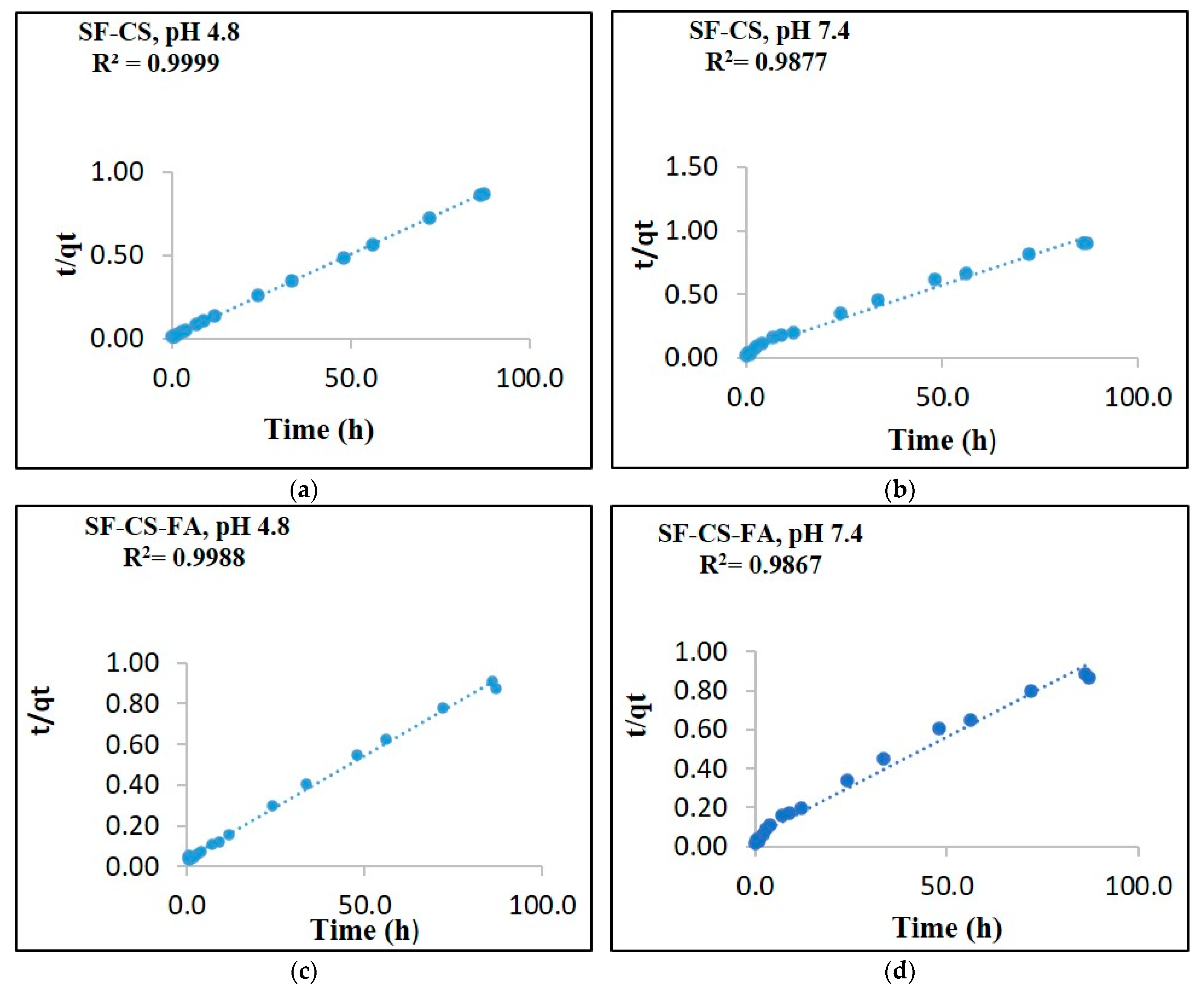
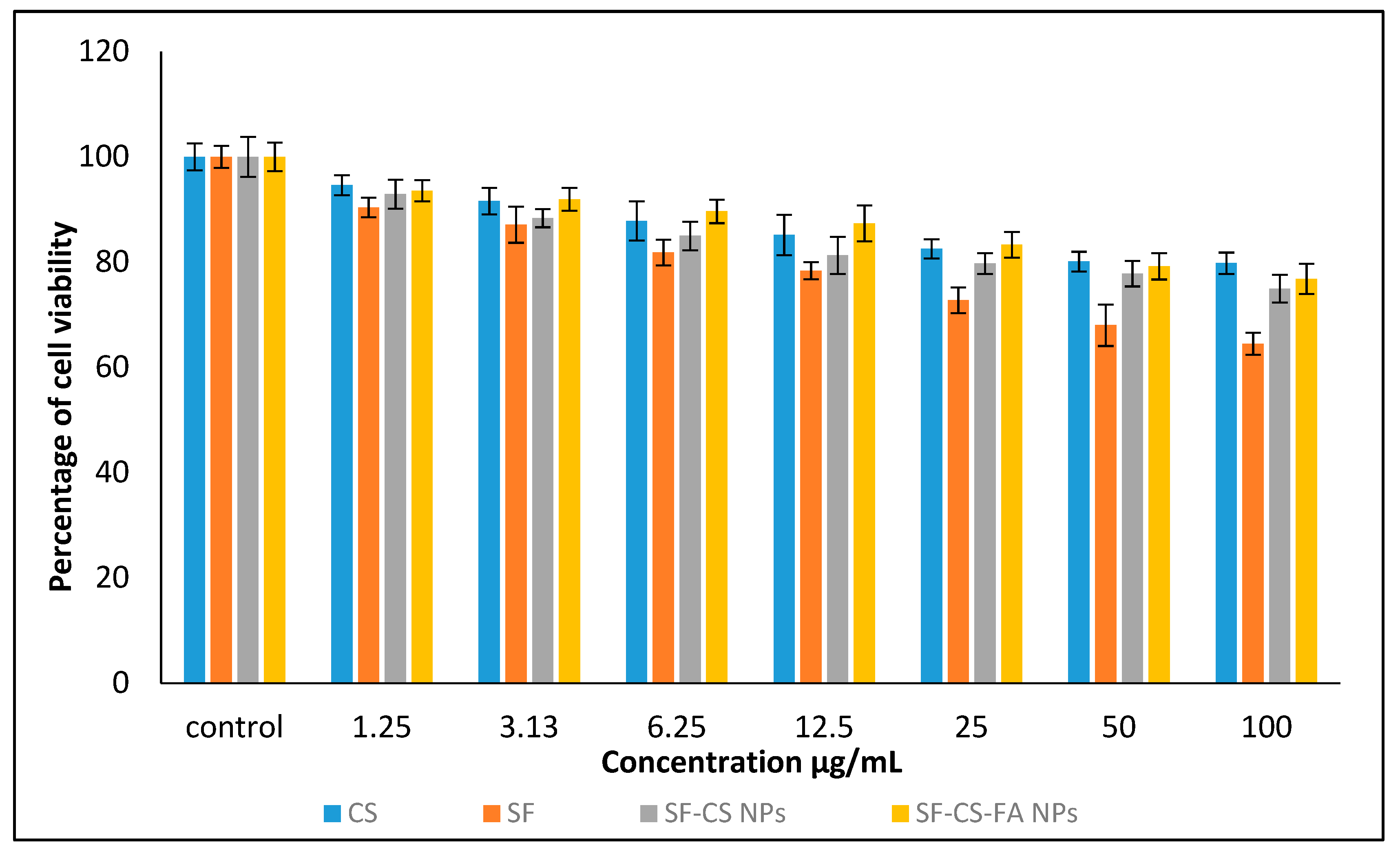
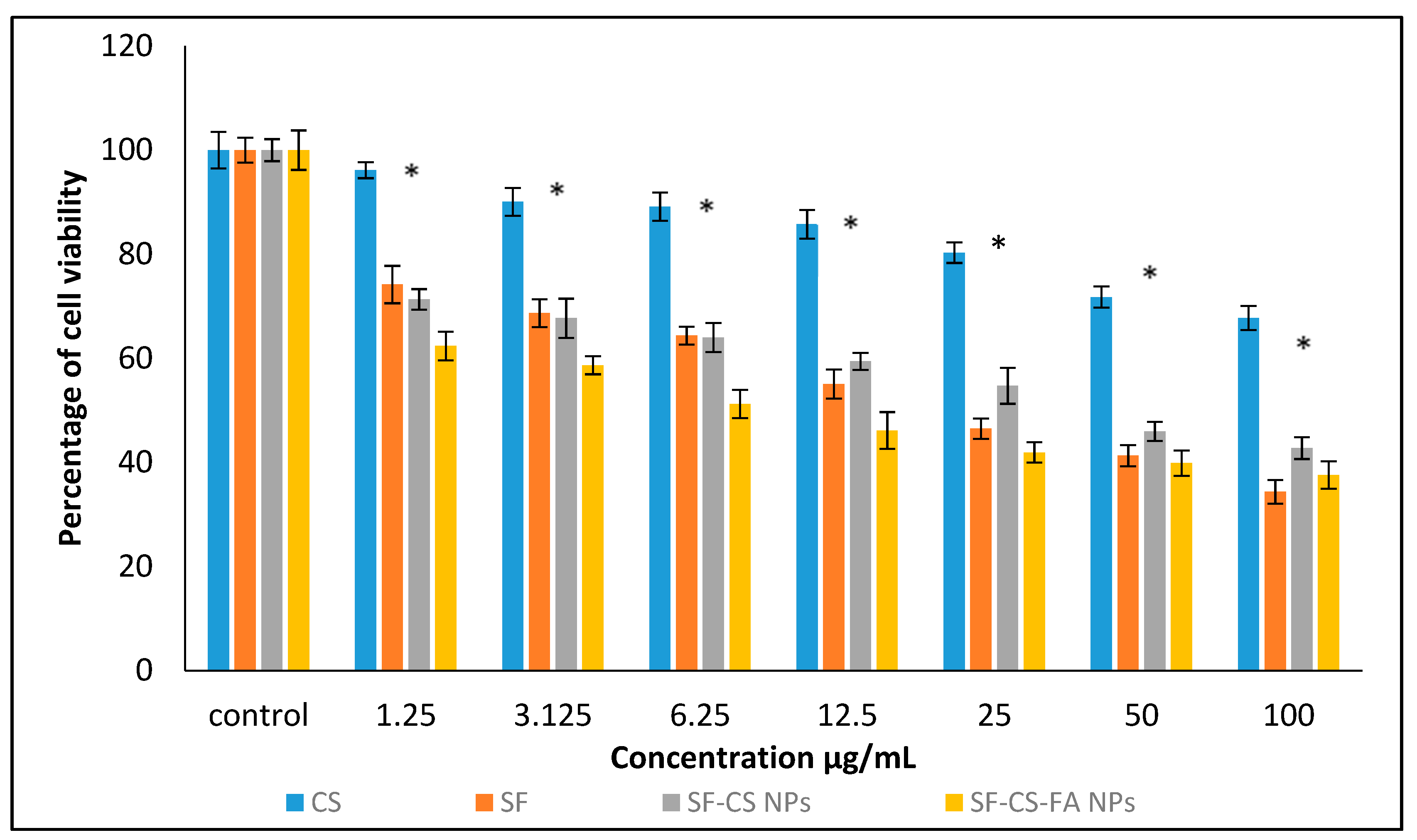
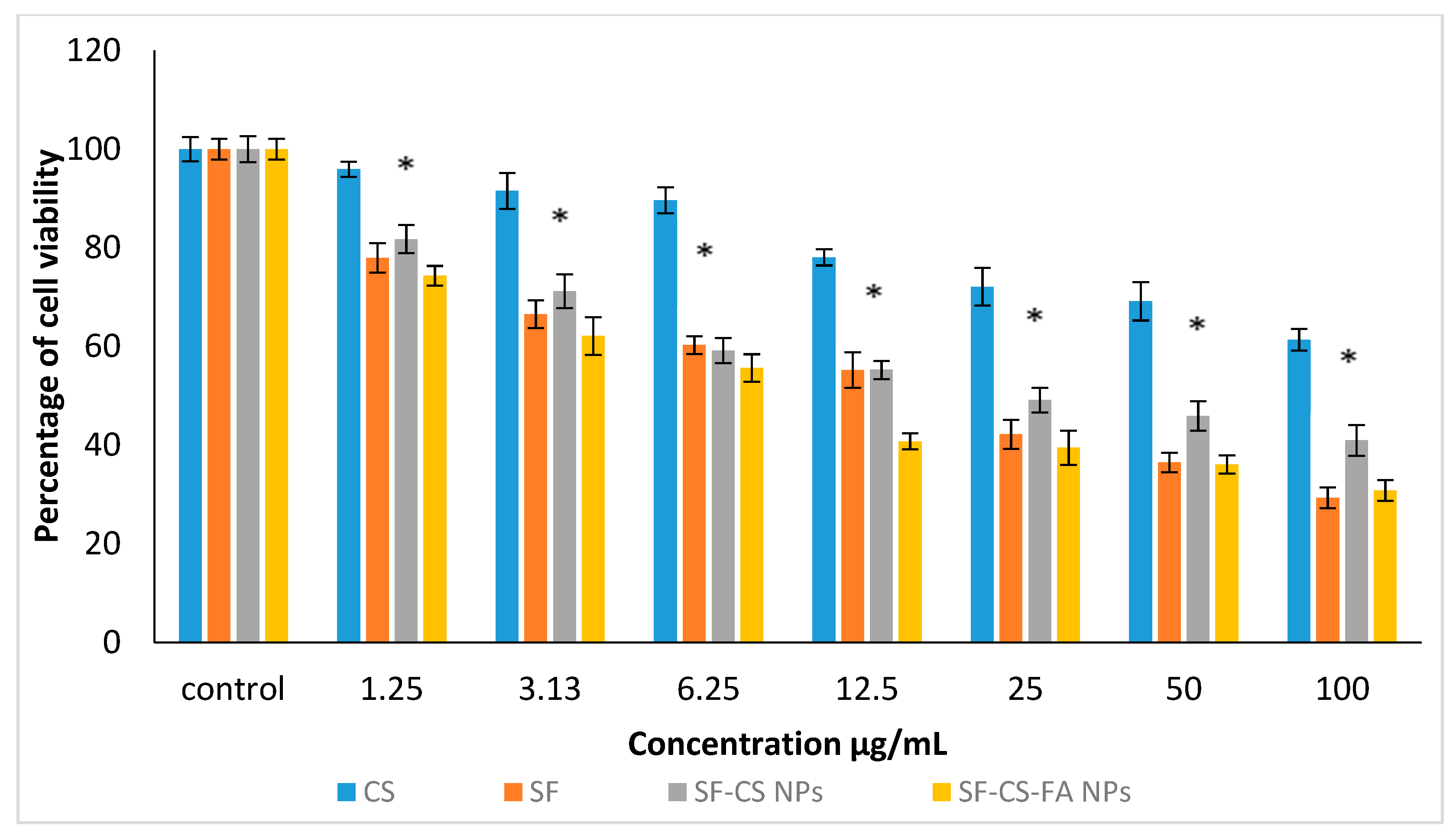
| Sample | Chitosan: Sorafenib ratio (mg/mL) | Size (nm) | PDI | EE (%) | LC (%) | Zeta Potentials (mV) |
|---|---|---|---|---|---|---|
| SF-CS NPs | 5:0 | 10.5 ± 9.6 | 0.22 | 0.0 ± 0.0 | 0.0 ± 0.0 | 7.9 ± 0.9 |
| 5:1 | 27.2 ± 12.6 | 0.19 | 20.2 ± 1.2 | 7.7 ± 0.5 | 8.7 ± 0.4 | |
| 5:2 | 30.8 ± 11.9 | 0.23 | 69.8 ± 3.3 | 12.2 ± 0.2 | 19.8 ± 0.4 | |
| 5:3 | 76.3 ± 13.7 | 0.28 | 83.7 ± 2.4 | 18.2± 1.3 | 31.5 ± 0.6 | |
| 5:4 | 67.9 ± 11.2 | 0.10 | 79.9 ± 1.9 | 14.8 ± 1.0 | 32.8 ± 0.5 | |
| 5:5 | 28.7 ± 7.8 | 0.45 | 49.8 ± 0.9 | 7.6 ± 0.6 | 37.7 ± 0.4 | |
| 5:6 | 15.4 ± 9.8 | 0.68 | 19.4 ± 1.3 | 6.9 ± 0.1 | 37.6 ± 0.1 | |
| 5:7 | 27.8 ± 5.0 | 0.92 | 3.7 ± 1.1 | 12.9 ± 0.4 | 31.8 ± 0.3 | |
| 5:8 | 14.9 ± 5.9 | 2.07 | 8.8 ± 0.5 | 6.0 ± 0.6 | 25.4 ± 0.7 | |
| 1:3 | 18.5 ± 7.3 | 0.09 | 9.8 ± 0.6 | 1.9 ± 0.0 | 17.6 ± 0.9 | |
| 2:3 | 47.6 ± 3.9 | 0.05 | 6.9 ± 0.9 | 8.9 ± 0.5 | 11.3 ± 0.8 | |
| 4:3 | 52.5 ± 4.2 | 1.19 | 9.0 ± 1.1 | 3.2 ± 0.6 | 27.9 ± 0.5 | |
| 6:3 | 66.3 ± 8.2 | 0.34 | 55.9 ± 2.6 | 12.9 ± 1.7 | 21.2 ± 0.5 | |
| 7:3 | 139.2 ± 2.7 | 0.21 | 34.9 ± 2.3 | 14.4 ± 1.7 | 34.4 ± 0.7 | |
| 8:3 | 120.2 ± 2.9 | 0.49 | 45.6 ± 1.9 | 9.9 ± 1.2 | 29.1 ± 0.4 | |
| 9:3 | 201.0 ± 3.8 | 5.07 | 19.7 ± 1.2 | 6.9 ± 1.8 | 24.7 ± 0.5 |
| Sample | CS: SF (mg/mL) | Folic Acid (g/L) | Size (nm) | PDI | EE% | LC% | Zeta Potentials (mV) |
|---|---|---|---|---|---|---|---|
| SF-CS-FA | 5:3 | 0.1 | 45.8 ± 4.2 | 0.05 | 2.00 ± 0.0 | 0.0 ± 0.0 | 27.6 ± 1.6 |
| 0.2 | 49.7 ± 7.2 | 0.09 | 7.9 ± 1.0 | 0.7 ± 0.5 | 21.1 ± 1.2 | ||
| 0.3 | 54.5 ± 9.3 | 0.11 | 12.8 ± 1.3 | 9.2 ± 0.2 | 27.2 ± 2.1 | ||
| 0.4 | 57.8 ± 10.2 | 0.16 | 13.7 ± 1.4 | 8.0 ±0.3 | 25.7 ± 1.3 | ||
| 0.5 | 62.6 ± 12.9 | 0.13 | 15.8 ± 1.4 | 8.8 ± 1.7 | 37.4 ± 2.1 | ||
| 0.6 | 61.5 ± 13.7 | 0.21 | 19.9 ± 1.9 | 7.56 ± 0.6 | 39.8 ± 0.7 | ||
| 0.7 | 78.7 ± 11.1 | 0.20 | 49.9 ± 1.6 | 11.13 ± 1.1 | 38.5 ± 0.6 | ||
| 0.8 | 81.7 ± 12.9 | 0.24 | 87.9 ± 1.1 | 19.9 ± 1.4 | 37.7 ± 1.4 | ||
| 0.9 | 89.9 ± 10.6 | 0.26 | 88.9 ± 1.5 | 16.7 ± 1.6 | 36.4 ± 1.5 | ||
| 1.0 | 91.5 ± 9.9 | 0.31 | 89.8 ± 1.6 | 17.9 ± 1.0 | 37.2 ± 0.3 | ||
| 1.2 | 140.6 ± 9.7 | 0.50 | 76.2 ± 1.9 | 15.2 ± 1.5 | 27.4 ± 0.5 | ||
| 1.4 | 165.8 ± 5.5 | 0.90 | 68.6 ± 1.1 | 11.8 ± 1.1 | 22.6 ± 1.7 | ||
| 1.6 | 180.5 ± 10.1 | 1.89 | 55.9 ± 1.2 | 9.7 ± 0.7 | 23.8 ± 1.5 | ||
| 1.8 | 289.9 ± 7.8 | 2.67 | 64.9 ± 0.3 | 7.7 ± 1.7 | 26.7 ± 0.5 | ||
| 2.0 | 298.1 ± 5.9 | 3.83 | 75.6 ± 1.9 | 4.9 ± 1.2 | 29.7 ± 0.5 |
| Synthesized Nanoparticle | Loading-Content (%) | Encapsulation-Efficiency (%) |
|---|---|---|
| SF-CS | 18.2 ± 1.3 | 83.7 ± 2.4 |
| SF-CS-FA | 19.9 ± 1.4 | 87.9 ± 1.1 |
| Atomic and Weight % | Element (%) | SF-CS NPs | SF-CS-FA NPs | CS-NPs |
| Atomic% | C | 46.9 | 48.9 | 36.4 |
| N | 7.6 | 14.2 | - | |
| O | 38.6 | 32.5 | 50.1 | |
| F | 4.2 | 2.9 | - | |
| P | 2.4 | 0.5 | 7.6 | |
| Cl | 0.6 | 0.3 | - | |
| S | - | 0.5 | - | |
| Na | - | - | 5.8 | |
| Weight% | C | 39.1 | 42.4 | 27.2 |
| N | 6.4 | 14.7 | 2.6 | |
| O | 40.1 | 35.3 | 39.2 | |
| F | 5.6 | 3.9 | - | |
| P | 5.3 | 1.2 | 14.7 | |
| Cl | 1.6 | 0.5 | - | |
| S | 0.8 | 1.3 | - | |
| Na | 1.3 | 0.6 | 13.96 |
| Sample | Max Release (%) | Pseudo-First-Order | Pseudo-Second-Order | First-order | Higuchi | Korsmeyer-Peppas | Hixon-Crowell | Pseudo Second Order Rate Constant (mg/min) K2 |
|---|---|---|---|---|---|---|---|---|
| SF-CS | 98 | 0.0388 | 0.9977 | 0.3971 | 0.8246 | 0.8677 | 0.4885 | 7.2 × 10−3 |
| SF-CS-FA | 88 | 0.8053 | 0.9877 | 0.3970 | 0.8246 | 0.8677 | 0.4533 | 8.5 × 10−3 |
| SF-CS | 99 | 0.8053 | 0.9999 | 0.3961 | 0.8246 | 0.8677 | 0.4533 | 7.6 × 10−6 |
| SF-CS-FA | 93 | 0.8053 | 0.9988 | 0.3970 | 0.8246 | 0.8677 | 0.4533 | 7.2 × 10−6 |
| Nanoparticles | HDFa | HepG2 | HT29 |
|---|---|---|---|
| IC50 (μg/mL) | |||
| Chitosan | N.C | N.C | N.C |
| Sorafenib | N.C | 21.6 ± 1.0 | 16.8 ± 1.8 |
| SF-CS | N.C | 20.3 ± 1.5 | 15.9 ± 2.0 |
| SF-CS-FA | N.C | 14.5 ± 2.5 | 13.0 ± 1.3 |
Publisher’s Note: MDPI stays neutral with regard to jurisdictional claims in published maps and institutional affiliations. |
© 2021 by the authors. Licensee MDPI, Basel, Switzerland. This article is an open access article distributed under the terms and conditions of the Creative Commons Attribution (CC BY) license (http://creativecommons.org/licenses/by/4.0/).
Share and Cite
Ruman, U.; Buskaran, K.; Pastorin, G.; Masarudin, M.J.; Fakurazi, S.; Hussein, M.Z. Synthesis and Characterization of Chitosan-Based Nanodelivery Systems to Enhance the Anticancer Effect of Sorafenib Drug in Hepatocellular Carcinoma and Colorectal Adenocarcinoma Cells. Nanomaterials 2021, 11, 497. https://doi.org/10.3390/nano11020497
Ruman U, Buskaran K, Pastorin G, Masarudin MJ, Fakurazi S, Hussein MZ. Synthesis and Characterization of Chitosan-Based Nanodelivery Systems to Enhance the Anticancer Effect of Sorafenib Drug in Hepatocellular Carcinoma and Colorectal Adenocarcinoma Cells. Nanomaterials. 2021; 11(2):497. https://doi.org/10.3390/nano11020497
Chicago/Turabian StyleRuman, Umme, Kalaivani Buskaran, Giorgia Pastorin, Mas Jaffri Masarudin, Sharida Fakurazi, and Mohd Zobir Hussein. 2021. "Synthesis and Characterization of Chitosan-Based Nanodelivery Systems to Enhance the Anticancer Effect of Sorafenib Drug in Hepatocellular Carcinoma and Colorectal Adenocarcinoma Cells" Nanomaterials 11, no. 2: 497. https://doi.org/10.3390/nano11020497
APA StyleRuman, U., Buskaran, K., Pastorin, G., Masarudin, M. J., Fakurazi, S., & Hussein, M. Z. (2021). Synthesis and Characterization of Chitosan-Based Nanodelivery Systems to Enhance the Anticancer Effect of Sorafenib Drug in Hepatocellular Carcinoma and Colorectal Adenocarcinoma Cells. Nanomaterials, 11(2), 497. https://doi.org/10.3390/nano11020497







